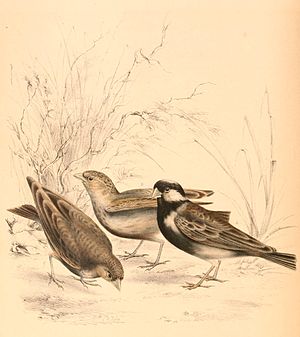Nun lark
| Nun lark | ||||||||||||
|---|---|---|---|---|---|---|---|---|---|---|---|---|

Nunnery, on the right the male |
||||||||||||
| Systematics | ||||||||||||
|
||||||||||||
| Scientific name | ||||||||||||
| Eremopterix verticalis | ||||||||||||
| Smith |
The nun lark ( Eremopterix verticalis ), sometimes also called gray-backed lark, is a very small black-gray and finch-like species from the lark family. Their distribution area is the south of Africa. There are four subspecies.
The stock situation of the nunlark was classified in the IUCN Red List of Threatened Species in 2016 as “ Least Concern (LC) ” = “not endangered”.
features
The nun lark reaches a body length of 12 to 14 centimeters. The beak length measured from the skull is 1.13 to 1.34 centimeters. They weigh between 12 and 21 grams. Unlike most larks, there is a noticeable gender dimorphism .
The males of the nun lark have a black head with a large white spot on the back of the head. White spots can also be found on the cheeks, the covers of the ears and a small white spot is on the neck. The top of the body is otherwise dark gray, the individual feathers have dark gray centers and are broadly lined with light gray. The upper tail-coverts are lighter than the rest of the upper side of the body and correspond in their color to the rump. The underside of the body is predominantly black. Only the flanks are gray to grayish white and there is a light gray to white spot on the upper chest sides. The wings are brown to grayish brown. The tail is dark grayish brown. The outermost control feathers each have a white outer flag and a white tip. The inner flags of the outermost control springs, on the other hand, are light brown.
In females predominantly gray-brown plumage tones. The head is predominantly brown, only the cheeks are whitish with dark speckles, the brown ear covers are narrowly striped light. The back and the coat are gray-brown with dark brown speckles, the upper tail-coverts are yellow-brown to whitish, whereby the individual feathers always have dark centers. The chest is brownish with light brownish speckles, the belly, however, almost black. The under tail-coverts are dirty white. The wings are brown.
Possible confusion
In the area of distribution of the nun lark there are other Eremopterix species which, like the males of the nun lark, have black head and belly markings. However, only the nun lark has a gray back color. The black- cheeked lark and the white-cheeked lark each have a maroon back. The respective females also differ from the overall dull and grayer female of the nun lark by the chestnut-colored plumage.
The Eremopterix lark with the greatest resemblance is the harlequin lark . However, this only occurs north of the equator.
Distribution area, subspecies and habitat
The distribution area of the nun lark is the south of Africa. It inhabits a coastal strip of Angola, all of Namibia, the extreme southwest of Zambia and the west of Zimbabwe. In the South African Republic, the nun lark is only absent in the east of the country.
The individual subspecies can be found in the following regions:
- E. v. khama - Irwin , 1957 : Occurrence in the northeast of Botswana, in the west of Zimbabwe and in the west of Zambia.
- E. v. harti - Benson & Irwin, 1965 : Occurrence in the southwest of Zambia
- E. v. damarensis - Roberts , 1931 : Occurrence in the west of Angola, in the southwest of Zambia and in the west of the South African Republic.
- E. v. verticalis - ( Smith , 1836) : Occurrence in the southeast of Botswana and in the southwest of Zimbabwe to the south of the South African Republic.
The habitat of the nunlark are semi-arid to dry areas with short grass, gravelly soils that are sparsely covered with grass and bushes, and loamy soils in dry river beds. The habitat includes the Karoo and Kalahari , which belong to the semi-deserts, thorn bush and dry savannas.
Way of life
The nun lark differs from many other lark species in that it lives socially even during the breeding season. The nun lark eats mainly seeds, in the Karoo the seeds of African logs predominate . To a small extent they also eat green plant material, otherwise they ingest insects. The nestlings receive predominantly animal protein, with locusts, termites and butterfly larvae predominating. Nunnery larks drink a lot and are therefore often seen at water points.
Nunnery broods all year round, but the breeding season is concentrated in the weeks after the rainy season. Like all larks, nuns are ground breeders. The typical cup-shaped lark's nest is built by the female from grass and roots. It typically takes four to five days to do this. The clutch consists of two to three eggs. The breeding season lasts 12 days and both parent birds breed. The nestlings leave the nest when they are seven to ten days old.
literature
- Rudolf Pätzold: The larks of the world . Westarp Sciences, Magdeburg 1994, ISBN 3-89432-422-8 .
- Rudolf Pätzold: Compendium of Larks. All the larks on earth. Jan-Schimkat-Medienpublikation, Dresden 2003, ISBN 3-00-011219-7 .
Web links
Single receipts
- ^ Pätzold: Compendium of Larks . P. 159.
- ↑ Eremopterix verticalis in the endangered Red List species the IUCN 2016 Posted by: BirdLife International, 2016. Retrieved on 9 October 2017th
- ^ Pätzold: Compendium of Larks . P. 156.
- ^ Pätzold: Compendium of Larks . P. 173.
- ↑ a b Pätzold: Compendium of Larks . P. 157.
- ^ Pätzold: Compendium of Larks . P. 158.

